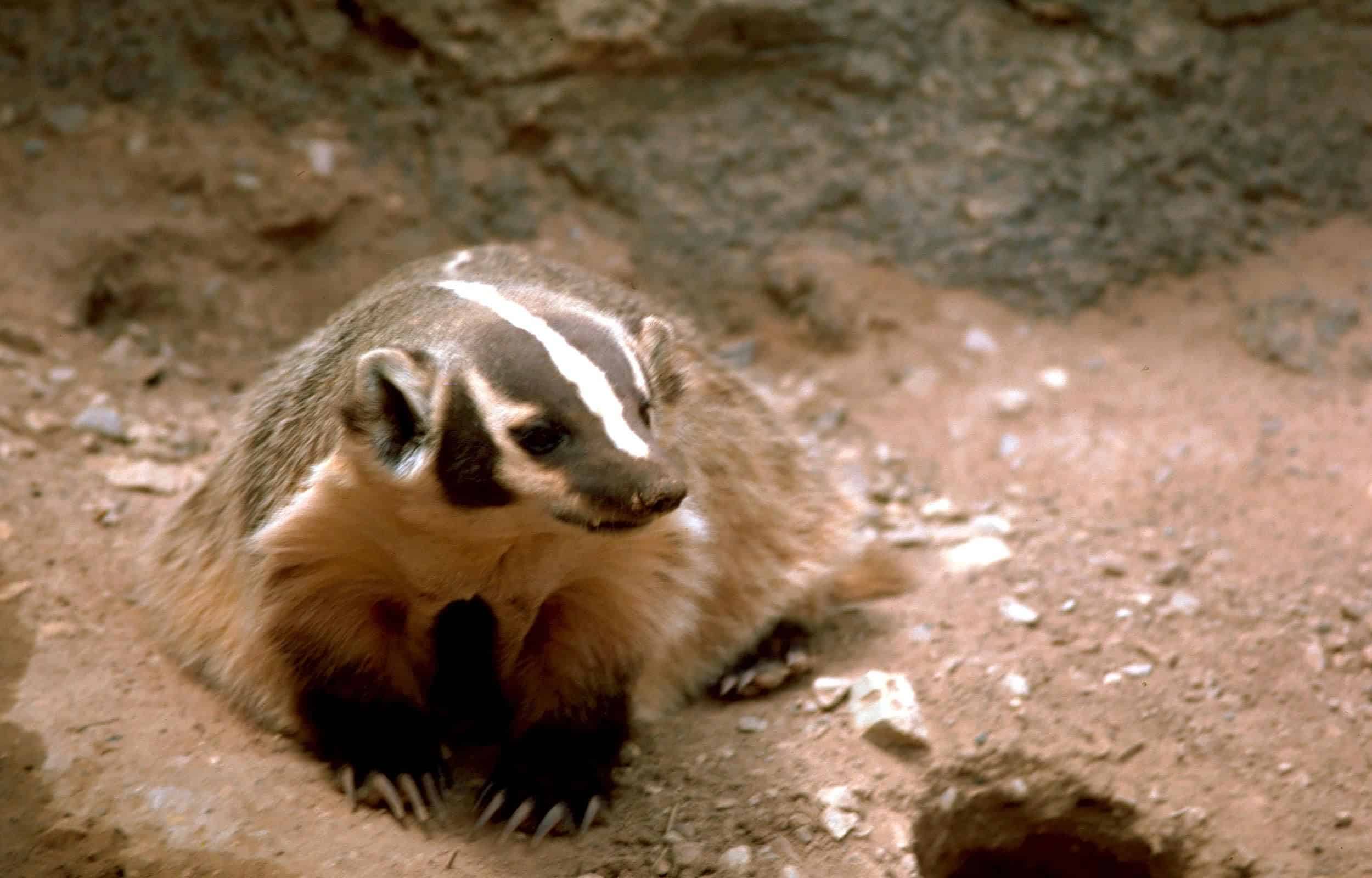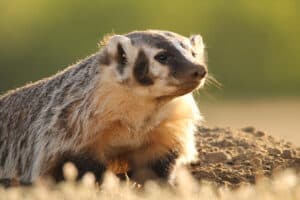Badgers are plentiful in Texas. They may look cute and cuddly as they shuffle through the Texas prairie, but these creatures are fierce and built specifically for defense. And these ornery animals have a reputation for being exceptionally grumpy, especially around humans.
Are they aggressive or just misunderstood? Find out everything you need to know about badgers in Texas, including where they live, what they eat, and why they get such a bad reputation.
About Badgers in Texas

American Badgers
live throughout Texas.
©Gary M. Stolz, U.S. Fish and Wildlife Service, Public domain, via Wikimedia Commons – License
American badgers are widespread throughout Western Canada, Southern Mexico, and the US. This badger species is from the skunk and weasel family, and you can find them around much of Texas. You can spot them by their stocky, flat-looking bodies and triangular faces. Their coloring is dark, with white stripes down their nose and near their eyes.
They have several features for defense: muscular necks (which make them hard to catch), long front claws, strong jaws, and sharp teeth. American badgers use vocalizations like hissing and growling to deter predators; they will even emit a fetid odor when threatened.
Badgers are solitary animals that venture from their territory only during mating season. The mating season for American Badgers is between late summer and early fall. Litters ranging from one to five are born from late March to early April. Juveniles then leave the den around the end of June to August. These quarrelsome creatures have few natural enemies but are vulnerable to species like eagles, coyotes, and bobcats. The average lifespan of a wild badger is 9 to 10 years.
Where Do Badgers Live in Texas?

Badgers live
in most areas of Texas, except for the extreme eastern parts.
©U.S. Fish and Wildlife Service, Public domain, via Wikimedia Commons – License
American badgers have a significant range across Texas and live in most areas in the state, except for the extreme eastern part. However, populations are starting to migrate further east due to land clearing and artificial grasslands.
Badgers prefer habitats with open areas of grassland, preferably treeless. But they will live in a wide range of environments, including meadows, marshes, forest glades, and hot deserts. Badgers in Texas are more prevalent in prairies and desert sections of the West. You will often find them in large expanses of uncultivated land.
Males have a more extended range, typically around 2,000 miles, especially during mating season. They live in setts, or underground burrows, which they dig with their long claws. They prefer to enlarge foraged-out prey holes for their dens, which they use for sleep, concealment, and protection. Badgers may use their shelter for a day or a week, then abandon it with the possibility of returning. Smaller wildlife will use abandoned burrow holes until their owners return.
American badger populations are not generally under threat, but their numbers are beginning to decrease due to the loss of their habitats. Urban development and agriculture practices run many wild animals away from their homes, including badgers. Moreover, their main diet consists of what many farmers perceive as a pest. The killing of this food source can also have detrimental effects on the badger population.
What Do Badgers Eat?

Badgers in Texas eat
prairie dogs
, mice, groundhogs, and insects.
©iStock.com/Jon Marshall
American badgers eat prairie dogs, insects, mice, groundhogs, and ground-dwelling birds. They are fossorial carnivores (meat-eaters living primarily underground), excellent diggers, and will often save food for later. Badgers have even placed rocks over holes to prevent prey from escaping.
Here is a list of animals an American badger will eat:
- Prairie dogs
- Pocket gophers
- Ground squirrels
- Moles
- Marmots
- Woodrats
- Kangaroo rats
- Deer mice
- Voles
- Snakes, including rattlesnakes
- Ground nesting birds
- Lizards
- Amphibians
- Skunks
- Fish
- Insects, including bees and honeycomb
- Carrion (dead animals)
In some parts of Texas, badgers will hunt alongside coyotes. These partnerships are relatively common, and researchers have seen this unlikely duo work together for over an hour. While badgers can become prey to coyotes, they will put up a fight and won’t go easy. The coyote quickly learned he had a better chance of catching dinner alongside this fierce carnivorous mammal.
The badger benefits from the coyote driving prey underground, and the coyote takes his game as the badger runs them out. This alliance exemplifies mutualism when different species work together to meet their individual needs.
Are Texas Badgers Aggressive?

Badgers have a terrible reputation, but they rarely attack humans.
©Jonathunder, CC BY-SA 3.0, via Wikimedia Commons – License
Badgers have a negative reputation. Many perceive the badger as a vicious and fierce wild animal that frequently attacks humans. This is simply not true. While this species is equipped with the tools it needs to inflict pain, it rarely does on humans.
Their bodies are built for protection to give themselves the best chance at survival, and they will do what it takes to survive. But this doesn’t make them dangerous. Any creature, including humans, will protect themselves in the face of endangerment.
Badgers typically run back to their dens when a human confronts them. The only time badgers seem to attack is when they are cornered and feel threatened. They may use their powerful jaws and sharp teeth to inflict a painful bite if this happens. The bottom line: badgers can be aggressive, but attacks on humans are extremely rare.
Are Badgers a Problem?
People consider badgers in Texas to be a mild pest. Similar to moles, badgers dig holes in gardens and crop fields. However, others believe their presence is more beneficial than harmful. American badgers control rodent populations and eat insects that spread disease and harm crops. They are one of the most essential carnivores in the grassland ecosystem. That said, you may want to prevent them from building their homes in your backyard, especially if you have animals and children.
You can use natural remedies to deter badgers from infesting your property and potentially causing harm to family members.
- Install a wire mesh fence around your property
- Place solar and sensor lights around your yard
- Spray human male urine around the perimeter (unorthodox but effective)
- Keep your garden clean by minimizing waste and food sources
- Sprinkle crushed scotch bonnet peppers in their sets and around your yard
- Apply citronella oil to your fencing
- Don’t resort to cruel tactics like trapping them in their den. Instead, contact a badger control specialist.
The photo featured at the top of this post is © Steve Boice/Shutterstock.com
Thank you for reading! Have some feedback for us? Contact the AZ Animals editorial team.






